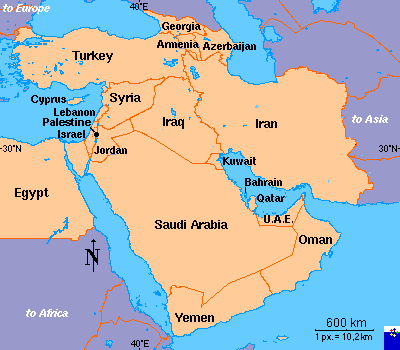Among the many ethnic groups that inhabit the Caucasus are the Azeris, a Turkic people who speak a language related to Turkish, but who are culturally closer to the Persians.
The Republic of Azerbaijan’s 9.4 million people inhabit a land 86,600 square kilometers in size. The country borders the Russian Federation’s republic of Dagestan to the north, Georgia to its northwest, Armenia to its west, and Iran to its south. It faces the Caspian Sea on its east.
Armenia also cuts off the very western section of the country, known as Nakhchivan, from the rest of the country, though this enclave, 5,500 square kilometers in size and with a population of 415,000, provides Azerbaijan with a 15-kilometer long border with Turkey.
Virtually the entire population of Azerbaijan is Muslim, with approximately 85 percent Shia and 15 percent Sunni.
Along with occasional rule by indigenous dynasties, the Azeris were at various times governed by Arab, Ottoman Turkish, and Persian empires, until incorporated into the Russian Empire in the early 19th century.
After the 1917 Russian Revolution, Azerbaijan became a full-fledged Soviet socialist republic. However, it also incorporated, in its southwest, the 4,400 square kilometer Nagorno-Karabakh Autonomous Oblast. Entirely enclosed within Azerbaijan, but not far from Armenia itself, this province was more than three-quarters Armenian by ethnicity.
As the the Soviet Union disintegrated, the parliament of Azerbaijan in 1991 abolished the autonomous status of the region, while the majority Armenian population declared their independence.
War ensued between the majority ethnic Armenians of Nagorno-Karabakh, backed by Christian Armenia, and Muslim Azerbaijan. By 1994, when a cease-fire went into effect, the new de facto republic of Nagorno-Karabakh had proved victorious and had enlarged its territory. Today, it includes some 140,000 residents, 95 percent of them ethnic Armenians.
Armenians now control all of the territory of the former oblast, plus conquered areas south to Iran and west to Armenia itself — the so-called Lachin corridor.
Of course, Baku has not reconciled itself to this situation, and refuses to accept either the independence of Nagorno-Karabakh or the loss of seven other territories within an Armenian-controlled “security belt.”
The “frozen” conflict remains unresolved despite negotiations that have been ongoing under the aegis of the Minsk Group of the Organization for Security and Cooperation in Europe.
Iran was quick to recognize Azerbaijan as an independent nation in 1992. It saw Azerbaijan, a Shia-majority state, as fertile ground for spreading its Islamic Revolution. But relations between the two countries quickly turned sour, as Baku expressed irredentist sentiments and promoted the idea of a “Greater Azerbaijan,” which would unite the country with the 16 million Azeris in northwest Iran.
In February 2012, a member of the ruling New Azerbaijan Party asked the government to change the country’s name to “North Azerbaijan,” implicitly suggesting that the Azeris who live in northern Iran are in need of liberation.
Fearing Baku’s intentions to fuel secessionism inside its borders, Iran provided vital backing to Armenia in its war with Azerbaijan — something that has not been forgotten.
Azerbaijan has openly accused Iran of interfering in its domestic affairs. Tehran has supported the Islamic Party of Azerbaijan (AIP), a pro-Iranian and religious Shiite opposition party officially banned by Baku.

The leader of the AIP, Movsum Samadov, called for the overthrow of President Ilham Aliyev’s government and was sentenced to 12 years in jail in 2011.
In 2012, 22 Azerbaijanis charged with spying for Iran’s Islamic Revolutionary Guards Corps were given lengthy prison sentences.
Instead, Azerbaijan has developed bilateral strategic and economic relations with Israel; they share the common goal of containing Iranian influence.
In a 2007 speech, the Israeli ambassador to Azerbaijan, Arthur Lenk, spoke of increasing trade between oil-rich Azerbaijan and Israel. The Jewish state is the second largest customer for Azeri oil, shipped through the Baku-Tibilisi-Ceyhan pipeline to Turkey.
In March 1996, then-Health Minister Ephraim Sneh became the first senior Israeli official to visit Baku. “I think that in the Caucasian region, Azerbaijan is an icon of progress and modernity,” Sneh told an Azeri magazine in 2010.

In 2009, the deputy chief of mission of the U.S. embassy in Baku, Donald Lu, sent a memo to Washington which quoted President Aliyev as describing his country’s relationship with the Jewish state as an iceberg, “nine-tenths of it is below the surface.”
Israeli President Shimon Peres visited that year, and accompanying him was Avi Leumi, head of Israel’s Aeronautics Defence Systems. In February 2012, Azerbaijan signed a $1.6 billion defense deal with Leumi’s company that included air defence systems, intelligence hardware, and drones.
A month later, the magazine Foreign Policy reported that Israel had been granted access to air bases in Azerbaijan on Iran’s northern border to serve Israel in a possible strike on Iran.
Access to such airfields would mean that Israeli fighter-bombers would not have to refuel midflight but could continue north and land in Azerbaijan. Such a possibility might be keeping Iran’s rulers awake at night.
Henry Srebrnik is a political science professor at the University of Prince Edward Island.


